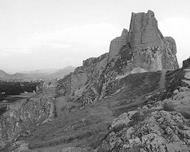Glossary (Treaty of Gulistan – Varanda)
Treaty of Gulistan
Signed in October of 1813 by Persia and Russia, the Treaty gave Russia the Khanates of Karabakh and Gandzak.
Treaty of Kars
Signed in fall, 1921 by Russia, Turkey, and the Bolshevik leaders of Armenia, Georgia and Azerbaijan, the Treaty of Kars asserted the Turkish annexation of the Armenian lands.
Treaty of Moscow
Agreement of “peace, friendship, and carve-up Armenia” signed in March, 1921 by Russia and Turkey. The Treaty marked the Armenian loss of Nakhichevan.
Treaty of Sevres
Signed on August 10, 1921 by the Ottoman government, England and France, the Treaty of Sevres bound Turkey to accept the independence of Armenia and agree to the boundaries drawn by US President Woodrow Wilson.
Treaty of Turkmenchay
Signed by Persia and Russia on February 10, 1828, it marked the end of the Russo-Persian war of 1827-1828. Following the Treaty, Persia ceded to Russia most of the Eastern Armenia.
Trebizond
(Trabzon, Trabizon) Port on the Black Sea (present-day Trabzon, northeastern Turkey). According to the administrative division of the Byzantine Empire made in 535 by Emperor Justinian I (527-565), Trebizond was included into the so-called First Armenia.
Turuberan
Historical province of the Greater Armenia, one of 15 ashkhars (worlds). Turuberan was also often called Taron and consisted of 16 cantons: Khut, Aspakunik, Taron, Arshamunik, Mardaghi, Dasnavork, Tvaratsatap, Govar, Hark, Varajnunik, Bznunik, Erivark, Aghiovit, Apahunik, Kor, and Khorkhorunik.
Urartu
(Arartu) Old Assyrian for Ararat, name given to Armenia in the ancient Assyrian texts.
Urmia
(Kaputan) Lake in the Parskahayk (Persian Armenia) province of the Greater Armenia, now in Iran.
Vachagan III the Good
King of Aghuank (487-510). He was offspring of the Aran dynasty. Moses Kaghankatvatsi describes with admiration his piety and church-building activities saying that Vachagan only built as many churches as there were days in a year.
Vagharshak
King of Armenia (149-127 BC). Known as Vagharshak I the Parthian, he founded the Armenian branch of Arshakuni dynasty. He introduced the institute of Nakharars.
Vagharshapat
(Nor-Kaghak, New City) See Echmiadzin.
Vahagn
Also called Vahagn the Dragonfighter, third son of Tigranes I. He was known for his exceptional strength and courage. Armenian tradition attributes some of the Hercules exploits to him. Vahagn was one of the Gods in the ancient Armenian pantheon.
Vahan Mamikonyan
Marzban of Armenia (485-505), nephew of St.Vardan Mamikonyan. He headed the new uprising against Persia. His obstinacy and military victories compelled the Persian king Vagharsh accepting the freedom of worship in Armenia. According to Sebeos, Vahan restored the peace in the country and reconstructed many of the churches that Persians had destroyed in the cities of Dvin and Vagharshapat.
Vahe
King of Armenia (351-331 BC). According to Moses of Khoren, he revolted against Alexander the Great and fell in battle, fighting for Darius.
Vahram Pahlavuni
(967-1045) Sparapet (Commander-in-chief) of the Armenian army. In 1041, he defeated the Greek troops under Ani. His military talent and heroic deeds were sung in the Armenian literature and popular songs. He built a monastery and a fortress of Marmarashen (9 km from today’s city of Giumri).
Van
 Ruins of Van fortress
Ruins of Van fortress
Situated on the eastern shore of the Van Lake in the ancient Vaspurakan province of the Greater Armenia (now in Turkey). The name Van derived from Biayna, other names applied to Van were Tosp or Tushpa. Some historians called Van, city of Semiramis, because the old legend attributed the building of Van to the legendary Assyrian Queen. The kings of the Kingdom of Ararat made Van their capital. The city especially prospered in the 9-10th centuries, under the princes and kings Artsruni. At the time of the Armenian Genocide of 1915, Van became symbol of the heroic Armenian resistance.
Vanakan
(Hovhannes Tavushetsi) Armenian scholar priest of the 13th century. Inspired by his teacher Mkhitar Gosh, he raised a number of illustrious scholars, such as Kirakos Gandzaketsi, Vardan the Great, Gregory Aknertsi and others.
Varanda
Region and principality in ancient and medieval Artsakh. The residence of the Princes of Varanda was in Avetaranots (present-day Avetaranots in the Askeran region of the NKR), and in Shosvaberd (Shushi).







